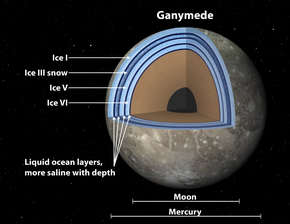Cryosphere
The cryosphere [ kryoˈsfɛːrə ] (from ancient Greek κρύος krýos , German 'ice cold, frost, ice' as well as ancient Greek σφαῖρα sphaira , German 'sphere, spherical body, ball, specifically earth globe' ) is the totality of the occurrence of solid water ( ice ) on a celestial body . Due to the low density of ice, it is usually located near the surface of the celestial body and can itself either form parts of this surface or even the entire surface.
Earth's cryosphere
The Earth's cryosphere includes:
- Sea ice and ice shelf
- Ice cap and mountain glaciers
- Ice in permafrost soils and ice caves
- Ice crystals in clouds as well as snow and ice sheets on inland waterways as general and seasonal components
It is part of the hydrosphere and, like it, part of the earth's system of spheres . The cryosphere of the Earth is of great importance for the climate system , because ice reflects due to its high retroreflectivity ( albedo ) a large amount of the sun outgoing radiation , including thermal radiation , into space. The expansion and retreat of continental ice sheets and sea ice areas therefore have feedback effects on the decrease or increase in the average world temperature.
Other heavenly bodies

While the cryosphere on earth has only an extremely small proportion of the total volume of the planet, this proportion is significantly larger for the solid objects in the outer solar system .
In the depths of such an ice moon , ice is likely to exist in so-called high - pressure modifications, each of which has a different crystal structure and a higher density than "normal" ice.
See also → Water ice deposits in the universe
Web links
- All About the Cryosphere. US National Snow and Ice Datacenter (NSIDC) website on Earth's cryosphere
Individual evidence
- ^ Wilhelm Pape , Max Sengebusch (arrangement): Concise dictionary of the Greek language . 3rd edition, 6th impression. Vieweg & Sohn, Braunschweig 1914 ( zeno.org [accessed September 25, 2018]).
- ^ Wilhelm Pape , Max Sengebusch (arrangement): Concise dictionary of the Greek language . 3rd edition, 6th impression. Vieweg & Sohn, Braunschweig 1914 ( zeno.org [accessed September 25, 2018]).
- ↑ Christiane Martin, Manfred Eiblmaier (ed.): Dictionary of earth sciences. 6 volumes. Spektrum Akademischer Verlag, Heidelberg et al. 2000–2002, ISBN 3-8274-1655-8 .
- ↑ Tilmann Althaus: Planet moon, Titan - a world with character . ASTROnews, February 24, 2012, accessed February 27, 2012.
